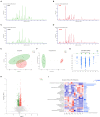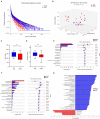Correlation Between Fecal Metabolomics and Gut Microbiota in Obesity and Polycystic Ovary Syndrome
- PMID: 33013704
- PMCID: PMC7505924
- DOI: 10.3389/fendo.2020.00628
Correlation Between Fecal Metabolomics and Gut Microbiota in Obesity and Polycystic Ovary Syndrome
Abstract
Objective: This study aimed to explore the relationship between the fecal metabolites and gut microbiota in obese patients with PCOS and provide a new strategy to elucidate the pathological mechanism of obesity and PCOS. Methods: The fecal samples of obese patients with PCOS (n = 18) and obese women without PCOS (n = 15) were analyzed by 16S rRNA gene sequencing and untargeted metabolomics. The peripheral venous blood of all subjects was collected to detect serum sex hormones. The association among fecal metabolites, gut microbiota, and serum sex hormones was analyzed with the R language. Results: A total of 122 named differential fecal metabolites and 18 enrichment KEGG pathways were obtained between the groups. Seven fecal metabolites can be used as characteristic metabolites, including DHEA sulfate. The richness and diversity of gut microbiota in the obese PCOS group were lower than those in the control group. Lachnoclostridium, Fusobacterium, Coprococcus_2, and Tyzzerela 4 were the characteristic genera of the obese patients with PCOS. Serum T level significantly and positively correlated with the abundance of fecal DHEA sulfate (p < 0.05), and serum DHEAS level significantly and negatively correlated with the abundance of fecal teasterone (p < 0.05). Conclusion: Specific fecal metabolites may be used as characteristic metabolites for obese patients with PCOS. The closely relationship among gut microbiota, fecal metabolites, and serum sex hormones may play a role in the related changes caused by hyperandrogenemia.
Keywords: biomarkers; gut microbiota; obesity; polycystic ovary syndrome; untargeted metabolomics.
Copyright © 2020 Zhou, Ni, Yu, Cheng, Cai and Yu.
Figures




Similar articles
-
Gut Microbiota and the Polycystic Ovary Syndrome: Influence of Sex, Sex Hormones, and Obesity.J Clin Endocrinol Metab. 2018 Jul 1;103(7):2552-2562. doi: 10.1210/jc.2017-02799. J Clin Endocrinol Metab. 2018. PMID: 29897462
-
Gut microbiota dysbiosis in polycystic ovary syndrome: association with obesity - a preliminary report.Can J Physiol Pharmacol. 2020 Nov;98(11):803-809. doi: 10.1139/cjpp-2019-0413. Epub 2020 Mar 9. Can J Physiol Pharmacol. 2020. PMID: 32150694
-
Integrated fecal microbiota and metabolomics analysis of the orlistat intervention effect on polycystic ovary syndrome rats induced by letrozole combined with a high-fat diet.J Ovarian Res. 2023 Jun 5;16(1):109. doi: 10.1186/s13048-023-01193-3. J Ovarian Res. 2023. PMID: 37277785 Free PMC article.
-
Balancing Act: Exploring the Gut Microbiota-Brown Adipose Tissue Axis in PCOS Pathogenesis and Therapeutic Frontiers.Front Biosci (Landmark Ed). 2024 May 30;29(6):208. doi: 10.31083/j.fbl2906208. Front Biosci (Landmark Ed). 2024. PMID: 38940030 Review.
-
Gut Microbiota in Patients with Polycystic Ovary Syndrome: a Systematic Review.Reprod Sci. 2022 Jan;29(1):69-83. doi: 10.1007/s43032-020-00430-0. Epub 2021 Jan 6. Reprod Sci. 2022. PMID: 33409871
Cited by
-
Effects of kefir consumption on gut microbiota and health outcomes in women with polycystic ovary syndrome.Food Sci Nutr. 2024 May 15;12(8):5632-5646. doi: 10.1002/fsn3.4212. eCollection 2024 Aug. Food Sci Nutr. 2024. PMID: 39139979 Free PMC article.
-
Fucoxanthin: A Promising Phytochemical on Diverse Pharmacological Targets.Front Pharmacol. 2022 Aug 2;13:929442. doi: 10.3389/fphar.2022.929442. eCollection 2022. Front Pharmacol. 2022. PMID: 35983376 Free PMC article. Review.
-
Assessment of gut microbial β-glucuronidase and β-glucosidase activity in women with polycystic ovary syndrome.Sci Rep. 2023 Jul 24;13(1):11967. doi: 10.1038/s41598-023-39168-5. Sci Rep. 2023. PMID: 37488157 Free PMC article.
-
Gut Microbiota and Oral Contraceptive Use in Women with Polycystic Ovary Syndrome: A Systematic Review.Nutrients. 2024 Oct 4;16(19):3382. doi: 10.3390/nu16193382. Nutrients. 2024. PMID: 39408349 Free PMC article.
-
The Role of the Gut Microbiome in Youth with Polycystic Ovary Syndrome: A Systematic Review.Children (Basel). 2023 Nov 29;10(12):1872. doi: 10.3390/children10121872. Children (Basel). 2023. PMID: 38136074 Free PMC article. Review.
References
-
- Forslund M, Landin-Wilhelmsen K, Trimpou P, Schmidt J, Brännström M, Dahlgren E. Type 2 diabetes mellitus in women with polycystic ovary syndrome during a 24-year period: importance of obesity and abdominal fat distribution. Human Reprod Open. (2020) 1:hoz042. 10.1093/hropen/hoz042 - DOI - PMC - PubMed
-
- Obesity Group Endocrinology Branch Chinese Medical Association Consensus on prevention of Chinese adult obesity. Chin J Endocrinol Metab. (2011) 27:711–7. 10.3760/cma.j.issn.1000-6699.2011.09.003 - DOI
Publication types
MeSH terms
Substances
LinkOut - more resources
Full Text Sources
Medical

